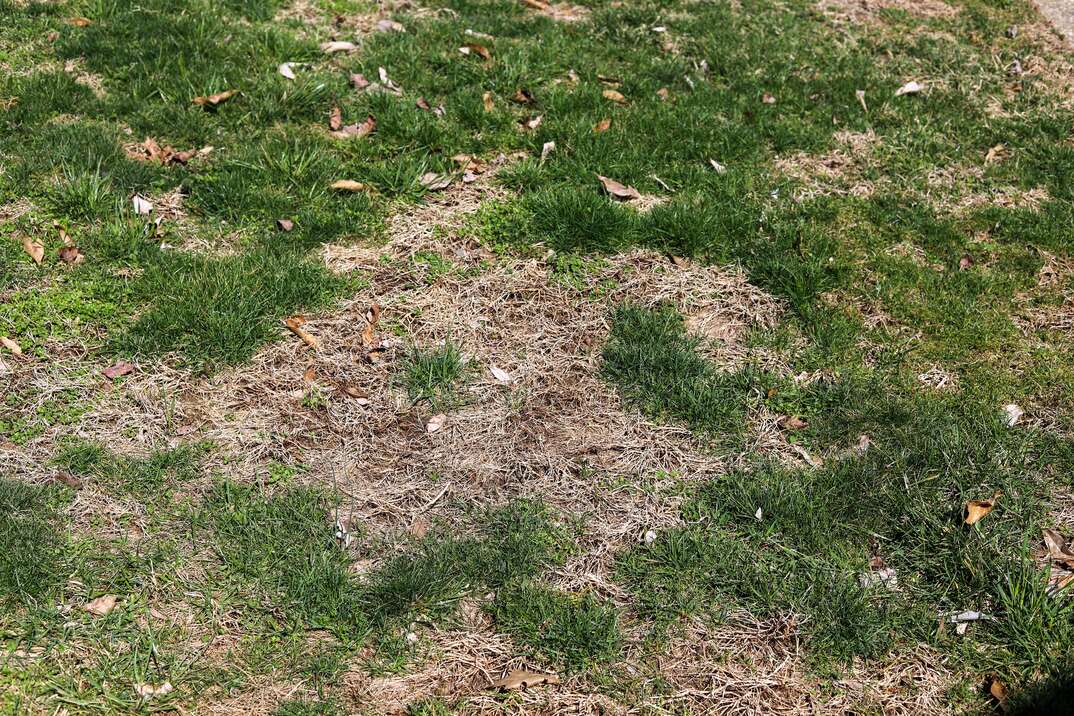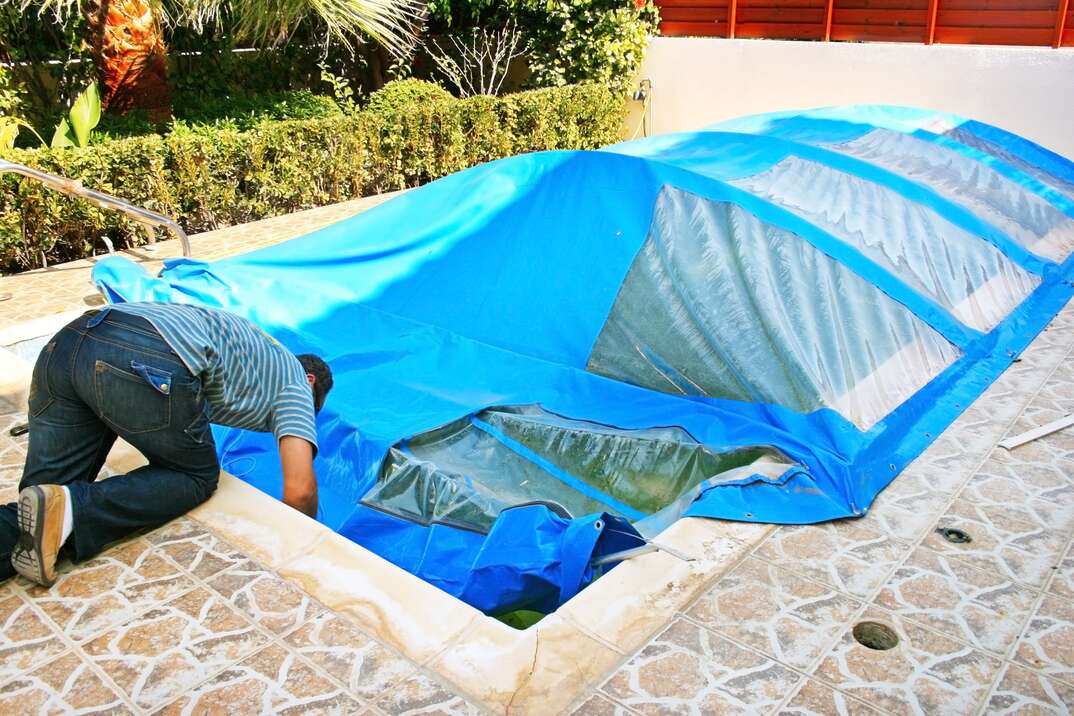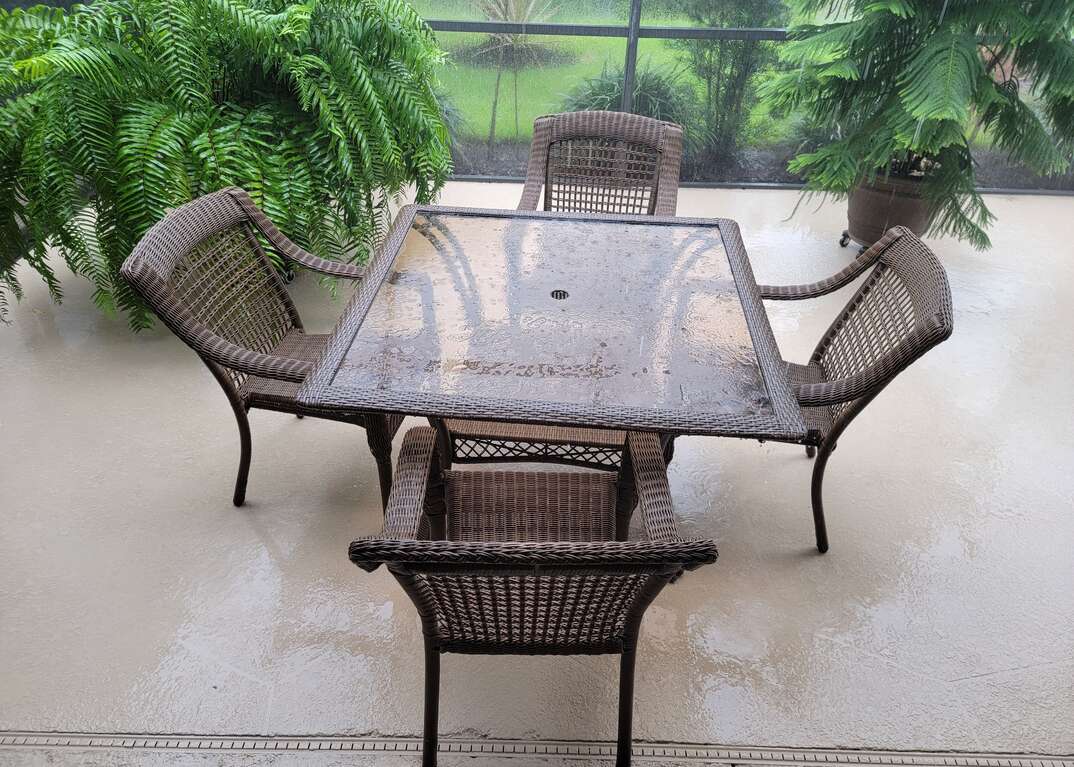Got Brown Patches and Bald Spots? Here's How to Fix Lawn Damage

Repairing Your Lawn at a Glance
- Tools & Materials: Grass seed, topsoil, fertilizer, rake, garden hose, mower, broadcast spreader, lime, gypsum conditioner, border barrier, soil activator
- Step 1: Mow
- Step 2: Rake
- Step 3: Aerate
- Step 4: Spread seed
- Step 5: Fertilize
- Step 6: Water
- Step 7: Spread soil activator
When you think of “curb appeal,” the image of a healthy and well-maintained front lawn is probably what springs to mind. However, dead and dying spots in your grass can easily up-end this visual appeal, which is something most homeowners wish to avoid.
This May Also Interest You: How Much Does It Cost to Aerate a Lawn?
The good news is that there are several lawn repairs you can do yourself — all without paying for professional lawn care. If you want to learn how to fix lawn damage and restore your yard back to vibrant health, read on to see how it’s done.
Tools and Materials
- Grass seed
- Topsoil
- Fertilizer
- Rake
- Garden hose
- Mower
- Broadcast spreader
- Horticultural lime
- Gypsum soil conditioner
- Border barrier (burlap sacks, landscape border fencing or snow fencing)
- Soil activator (optional)
How Do I Fix Dead Spots in My Lawn?
Some of the most common reasons for dead spots are pests (like insects and burrowing animals), dog urine and runoff from the de-icing salts used for winter road treatments. Here’s how to treat a lawn suffering from these issues:
Pests
Insect infestations can be difficult to recognize, but they often show up as small, isolated brown spots on your lawn. If you’re lucky, you might be able to spot the critters by visually inspecting the dead spot. However, most of the problematic insects that wreak havoc on lawns are 1/8 to 1/4 inch long, so they may be hard to see.
If you suspect that insects are the cause of your lawn’s dead spots, you can apply a broad-spectrum pesticide to the area. As a more natural and eco-friendly alternative, diatomaceous earth can be spread on the area instead. In either case, the insects should be dead within a couple of days.
Lawn damage from burrowing animals like gophers and moles will show up as mounds of dirt around a small hole in your lawn. Fortunately, there are several ways to eliminate these pesky critters from your yard. Try:
- Castor oil: Castor oil upsets the digestive tract of both moles and gophers and can act as an excellent, eco-friendly deterrent. Add four tablespoons of castor oil to a gallon of water, and soak the holes with the mixture.
- Commercial repellents: You can purchase granulated or liquid repellents to be spread over the entire lawn. Granulated repellants can be spread by hand or with a broadcast sprayer, and liquid repellents are typically attached to the end of a garden hose and sprayed over the lawn.
- Ultrasonic pest control device: These devices have a spiked end that’s inserted into your lawn and send ultrasonic pulses into the ground, repelling these animals.
- Traps: There are several different types of traps that are designed to either catch or kill gophers. Some models are inserted over the mound or hole, and others are inserted into the ground.
Once the offenders have been eradicated, it’s time to patch the holes. Flatten out the mounds of dirt by pressing it down into the hole. Add new topsoil to any low spots or depressions and spread fresh grass seed on the area.
Dog Urine
Although a dog’s waste can act as a beneficial fertilizer for your lawn, the highly acidic nature of dog urine can damage lawns if it remains on one spot too long. When this happens, patches of yellow dead or dying grass can result.
The best defense against the formation of these spots is to thoroughly water the area with a garden hose right after a dog has soiled it. It’s unlikely, however, that you’ll catch your dog in the act on every occasion. Consequently, keeping your lawn on a regular irrigation schedule will help to passively dilute any urine spots and decrease the likelihood that they will damage your lawn.
If damage has already been done, you can spread a light layer of horticultural lime onto the affected spot. Lime neutralizes the urine’s acidity by reducing its pH, but adding too much can cause just as much damage. You can prevent that by only using the amount recommended by the manufacturer. Afterward, water the spot daily until the yellowing disappears. If the spot doesn’t clear up in a couple of weeks, you may have to remove the patch of grass and lay down fresh sod.
Salt Damage
Many regions salt their public roadways during the winter months to prevent ice formation on the roads. Unfortunately, lawns located near these roads can become damaged when runoff from the salt is absorbed into the grass. When this happens, discolored sections of grass can be seen around the perimeter of your lawn nearest the road.
Salt-damaged grass should be treated as soon as possible to prevent permanent damage. If you first notice signs of salt damage during the winter while the roadways are still being salted, the best thing to do is erect a physical barrier around the border between the road and your lawn. To this end, you can use burlap sacks or screens, landscape border fencing or snow fencing.
The first step is to remove the salt residue from the damaged section of grass. Thoroughly soak the area with your garden hose once a day for several days. Afterward, spread a layer of gypsum soil conditioner over the area. Gypsum replaces the salt with chemical elements that repair the grass and stimulate new growth. Gypsum also promotes moisture retention while reducing soil erosion.
More Related Articles:
- What Does It Mean to Aerate Your Lawn and Should You Do It?
- How to Mulch Your Yard
- How ‘Mulch” Will It Cost? What You’ll Pay to Mulch Your Yard
- Mow Money: Here’s How Much Lawn Care Services Cost
- How Much Does Sod Cost to Install?
How Do I Bring My Lawn Back to Life?
If your entire lawn is riddled with brown patches and bald spots, it might be in need of a complete overhaul. This is done by adding new grass seed, or “overseeding” your lawn.
Any underlying causes of dead spots (see above) should be addressed before overseeding your lawn. Many of these steps can also be used on individual damaged spots by starting at step 4; just ignore the instruction to spread the seeds over your entire lawn.
The best time of year for this project is spring or fall when temperatures are mild and the grass seed is most likely to successfully establish itself. When you’re ready, take the following steps to reinvigorate your lawn:
Step 1: Mow
Mow the grass down to a height of about two inches.
Step 2: Rake
Rake up the freshly mown grass clippings. Rake over bare patches of soil to reduce compaction.
Step 3: Aerate
Aerate your entire lawn to reduce soil compaction and allow air, water and nutrients into the soil. There are several types of aerators you can use, including spike or core aerators that can be powered manually or mechanically. Consult a lawn care professional for recommendations on the best type to use for your lawn.
Step 4: Spread Seed
Get a lawn seed that matches your surrounding lawn, or one that’s native to your region. Spread a layer of seed onto any bare spots on your lawn and cover with a light layer of topsoil. Then, spread seed over the whole lawn using a broadcast spreader. Criss-cross the spreading pattern by performing one pass horizontally across your lawn and another pass perpendicularly.
Step 5: Fertilize
Select a fertilizer formulated for lawns. If you’re just filling in bald spots, then apply the fertilizer to the seeded area at a rate indicated by the manufacturer. For overseeding, spread the fertilizer over your entire lawn. Fertilizer pellets can be effectively spread with a broadcast spreader, and liquid fertilizers will likely attach to your garden hose. Rake the seed and fertilizer into the soil.
Step 6: Water
Thoroughly irrigate the lawn to promote the germination of your newly planted seeds. Water at the rate indicated by the manufacturer of the seeds.
Step 7: (Optional) Spread Soil Activator
Soil activators promote moisture retention, aerate the soil and reduce erosion. Spread soil activator over your lawn two weeks after seeding and fertilizing.


